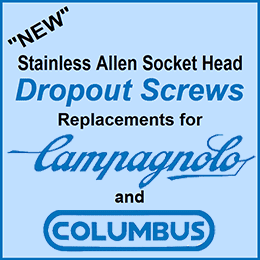Prices then and now
 Mon, February 20, 2017
Mon, February 20, 2017 
Above is a retail price list for my bikes in 1990. The most expensive is the Fuso Lux which was custom built to order, with chrome plating, and retailed at $3,150 equipped with Campagnolo C Record components. This was probably the most you would pay for any top of the line racing bicycle.
I say this because my competition back then were the Italian imports like Colnago and Pinerello. You would pay a something over $3,000 for one of these lugged steel Italian bikes equipped with the same Campagnolo C Record group.
My production was only a fraction of these much larger companies, they probably each produced far more frames in a month than I did in a year. But I was able to compete because I had a much lower overhead, and I did not need a distributor to sell my frames in the US. It was the shipping and middle man cost that the Italian companies had to deal with that allowed me to compete.
I attended the big bicycle trade shows each year, and gradually built up a network of bicycle dealers all over the US. I could then sell and ship direct to them. My competition, the Italian bike builders, could not do this. The shipping costs alone on individual bikes or frames would have been prohibitive.
They had to ship frames over by the container load to a distributor, who would then market and sell to the individual American bike dealers just as I did. The Italian import frames were mostly built on a system made by a company called “Marchetti and Lange.” This was a conveyer track system, where the frames were completely assembled, front and rear triangle, and “Pinned” together, then placed on the conveyer.
Gas jets pre-heated first the bottom bracket area, the conveyer then moved on, with the bottom bracket and tubes glowing red hot from the pre-heating, and an operator quickly hand brazed the bottom bracket. While this was happening, gas jets were pre-heating the head lugs. Then the conveyor moved on to a second operator who would then braze the already pre-heated head lugs, and so on until a completed frame came off the other end.
By comparison I brazed together batches of 5 frames at a time, using a hand held oxy-acetylene torch with no pre-heating. This meant less heat went into the tubes, so the Columbus tubing retained more of its inherent strength. I don’t mean that the Italian frames were over-heated, but just a larger area of the tube beyond the lugs was heated, due to the use of pre-heaters.
The Italian frames came off the Marchetti and Lange track, were cleaned up and went to be chromed and painted. They mostly left the factory, with the bottom bracket threads not cleaned out, the BB and head tube were un-faced, and the frames were unchecked for alignment.
This work was done after the frames arrived in the US, either by the distributor, but most often by the bicycle shop. Any top of the line bike shop in the 1980s or 1990s had a full Campagnolo tool kit in a wooden case.
By comparison, I would braze 5 bottom brackets, check for alignment. Braze 5 head tubes, check the alignment, and so on. Every frame had the BB thread tapped and faced, and the head tube was reamed and faced ready to accept the head bearings. The seat tube was reamed, so the seat post would slide right in. All this was done before painting, along with a final check for alignment. When a dealer got the frame it was ready for assembly.

What I find interesting is the price comparison from 1990 to now. The most you would pay for a top of the line race bike was a little over $3,000. You might go to $4,000 for something special like Columbus Max tubing. (Picture above.) However, this would be an exception. Today a top of the line carbon fiber Colnago or Pinarello can set you back $12,000.
The average income in 1990 was $29,000, today it is more than 2 1/2 times that at around $73,300. A Ford Mustang convertible cost $14,250 in 1990, today it would be less than twice as much at $25,500. So the cost of a CF bicycle today would almost buy you a Ford Mustang in 1990. Whereas the cost of a Ford Mustang is less today when compared against income.
Back when I built frames, as a small individual builder, I could compete with the larger import companies and still make a fair profit. Today, top of the line bikes are made by large corporations, and prices are not based on what it costs to produce, but rather by what the market will stand. With a consumer, it seems, who would rather pay more, if only for the bragging rights.
Previously posted in Feb. 2014. The price comparisons have been updated to reflect today's figures. It seems CF prices have dropped since 2014. Could it be consumers are balking at these over inflated prices. What do you think?



















Reader Comments (17)
I bought one of your bikes in 1984 or 85 when I was at Camp Pendleton. I think it was a shop in San Marcos.
I built frames in my own shop in San Marcos from 1983. The nearest retailer was in Visa a town next door. I moved 60 miles north to Temecula in 1986, where I stayed until I left the business in 1993.
Dave
That stem is a work of art.
i've seen more than a few cracked Rossin, Basso, Colnago etc. over the years... over baked tubes, really awful peeling chrome, and a tendency to rust under the paint.
Why pay for bullshit marketing and greed!
Moulton #1834
No doubt high end steel frame bikes are a much better deal now than in 1990 and I have no interest in substituting my steel for CF.
I have no idea on how much CF bike costs have fallen recently and really don't care.
High end bikes are more affordable to the average California income earner than to most other states in 1990 and in 2015. A wise move on your part Dave to be in southern CA in the 1980s where bikes can be ridden year round. Riding a nice bike with high end components in salt and sand in winter requires continuous cleaning - thus less likely to use one. Cyclists in CA can get much more time on their bikes and with less required maintenance.
And of course this rounded off data does reveal how skewed the data would look if we just used Silicon Valley,...
According to the BEA on per capita income 1990 & 2015:
USA: 1990 $18,700 in '90 to $47,700 in '15.
CA: $20,700 to $52,700
WV: $14,000 to $37,000
MO: $17,400 to $42,700
NC: $16,300 to $40,600
Those were pretty nice (though high for the time) deals on those bikes. Custom bikes (or semi-custom) have always been expensive in this country. For good reason too.
I'd buy a Fuso today, if I could find one in 58-59 cm and within my budget. They look like beautiful bikes, and knowing something of the artist who built them makes them that much more special.
When I got my first 'real' job, I treated myself to a Waterford bike frame - hand-built in the old Schwinn factory in Waterford WI. The frame is a little beaten up now, but it rides as well as it ever has. It's a beautiful bike and while I can no longer afford items like this, I have never had any regrets about buying this frame.
I have no problems with carbon-fibre bikes. They have a place, but for me steel is real.
I think you are spot on that today "prices are not based on what it costs to produce, but rather by what the market will stand". That is certainly true for top of the line bikes from some well-known brands.
But at the same time I think that cost to produce such bike is actually far higher now than in 1990. Bicycles became much more complex. Top of the line bikes may have frame shape optimized in a wind tunnel, wireless electronic shifting, power meters, custom carbon wheels, etc. All those gadgets add up. By comparison, top of the line steel bike from 1990 looked much simpler. And cheaper to manufacture.
Dave, I Think Dr.J hit the nail on the head about the new high tech bike company's. this is probably why they are not interested in your offer of expertise. Its a different world now. I have a 7 year old grandson that knows more about PCs than I do.
I still have two, 55 year old, bikes that were custom built for me by a local bike store, L'expres in Antwerp Belgium, that used the same Italian style production method. They have note been used extensively but the chrome and the paint are like new.
Hi Dave,
This is deja vu all over again for me re; the mass production of Italian bikes.
In 1988 after emigrating to British Columbia Canada, I wandered into the local road bike shop looking to start riding again after an 8 year layoff, asking the crusty Irishman that owned the place about a road bike. When I left England I was on a Holdsworth road and Condor track bikes, so I was a bit unsure of what was what. I asked about Colnago Pinarello etc. he said what you thought you were getting and paying for wasn’t the case, going onto explain the amount of bikes they sold and how it was achieved. From then on I have had and kept a succession of mostly custom bikes with various combos of Columbus tubing dripping in chrome Campag Cinelli etc. built by an Italian but in Quebec Canada, based on the simple criteria of knowing what you were getting. I’ve had and still have no inclination for Italian built bikes with the exception of a Masi Prestige and Team 3v. as I believed Mr. Masi throughout that time kept the integrity of what he put his name on.
The price difference between different generation top of the line bikes is quite stark, but the comparison between a bike built by a craftsman for a client and something designed by a focus group and bean counter for the punter that would also wait outside an electronics store all night for the next variation of an “I’ something to upload to the strava account 1 millisecond faster, has another aspect if a comparison is made between a craftsman built bike for a client then and now.
The price of a bike is really ramped up if rigged with electronic groupsets, and crazy wheels but with an upper mid range mechanical groupo and wheels or handbuilts, it’s quite feasible to have a custom built steel bike built with updated versions of traditional tubesets, then adjusting the price for time and tide would be quite comparable.
Most of the well known bike makers as well as others have a steel frame in their range, so if one is up to snuff on sizing and mechanichals, gets the timing and exchange rates right can still end up with something pretty nifty without breaking the bank.
Hi Dave,
this seems like a good time to tell you of a comment made by Colin Laing,
another expat frame builder who I knew. he was apprenticed to Jack Taykors
and has built thousands of frames. he said, and I quote " ....I have seen everything and every make and the two best buliders were Eisentraut and a guy called Dave Moulton"
I f I can find the forum link I will post it.
al lthe best Jim
,
Big fan of your work, hope one day to find one of your bikes for sale.
Back in the fall of 1975 I was introduced to you long distance by my Alaska Pipeline roommate a former British racer who told me his buddy Dave built excellent custom frames. We both thought the timing was good on two fronts, one, I was making more money than ever working on the pipeline, and two) the English pound had just been devalued.
I remember a little back in forth with you through the mail figuring out just what I wanted and siding the frame before I ordered it. As I recall, I paid $250.00 US dollars for a full custom built Moulton frame!
I was at Boone Cycles in Houston in 1984.
I was looking hard at an expensive Cinelli SC
When they mentioned the Dave Moulton John
Howard frame custom. It was a bargain in
comparison. They measured me and.......some time
later the frame appeared. It was great!
Stewart.
An old blog. But here is something interfering from Doug Fattic today.
Tell me something about your journey to learn to build frames? Who are what were your inspirations? How long does it take to make one lugged custom frame (not including paint)? That one in particular is a bit rude to ask, especially if the information is not kept private. Most of these questions went to those a generation or two younger than me. I’m not a journalist and didn’t get their permission to quote them (particularly the 3rd question!). But I can combine answers to give you a general sense of their framebuilding journey.
It took quite a long time for all of them to get a solid footing. Most of them had to start by taking a class because it is no longer possible to learn in some kind of apprentice program or working in some establishment. Some took more than one class (I have actually had a number of students that have already taken a framebuilding class before they took mine. Two weeks goes by pretty fast - my classes are 3 weeks long - and quality among classes varies). Their barriers to entry include finding and/or affording shop space to build (garages were often mentioned) and buying the expensive equipment required that can save them time. Nobody but relatives and friends wanted their first builds. Most of them said it took a few years until they felt they could make a professional quality frame that would be desired by the public.
As far as inspirations, most of them had looked at bicycles at shows and looked at pictures in magazines and online. All of them mentioned the builders in my generation and Albert Eisentraut was mentioned more often than I expected. There is always going to be tension between making a lugged frame as beautiful as possible with nicely filed lugs and making it as quick as possible to keep the price down and the profits up. Most often the winner was not based on making money.
Almost every builder I talked to said it took them between 80 and 100 hours to build a custom one-off frame. The question was not how fast they could build a rideable bicycle but rather one up to the standard they were willing to present. A bit of background on this question. I know British builders in the late 60’s to middle 70’s era (where a frame cost between $100 and $150) could build one a day (it took us about 4 days on average at Ellis Briggs because it was not the profit making section of their business but rather their purpose was to add prestige to their image). American builders making a decent but not spectacular frame typically take between 16 and 20 hours (+ -). This is usually the sweet spot for business success. They can be made fast enough and profitable enough so an impatient customer doesn’t have to wait too long or pay too much (in their opinion). Many bicyclists are not aware of the refinements at this level that can be done to make them nicer.
My takeaway is that a custom frame is one of the great bargains in the US. I can’t think of another craft or trade (unless perhaps art or jewelry) that requires as much experience, equipment and time to make that is sold for as little as they are. The word “little” is a reference to the ratio of quality to cost and not that a custom frame is inexpensive. Keep in mind that those 80 to 100 hours are only part of a framebuilders time. He isn’t being paid when he does accounting, fixes machinery or answers inquires or questions. A lot of time can be spent in marketing and branding. Next time I’ll ask what percentage of their time is spent on making a frame compared to everything else required to run a business.
Doug Fattic, acting like a journalist in Philly but really teaches framebuilding in
Niles, Michigan USA
John B,
I'm confused. Your point is what?
Dave